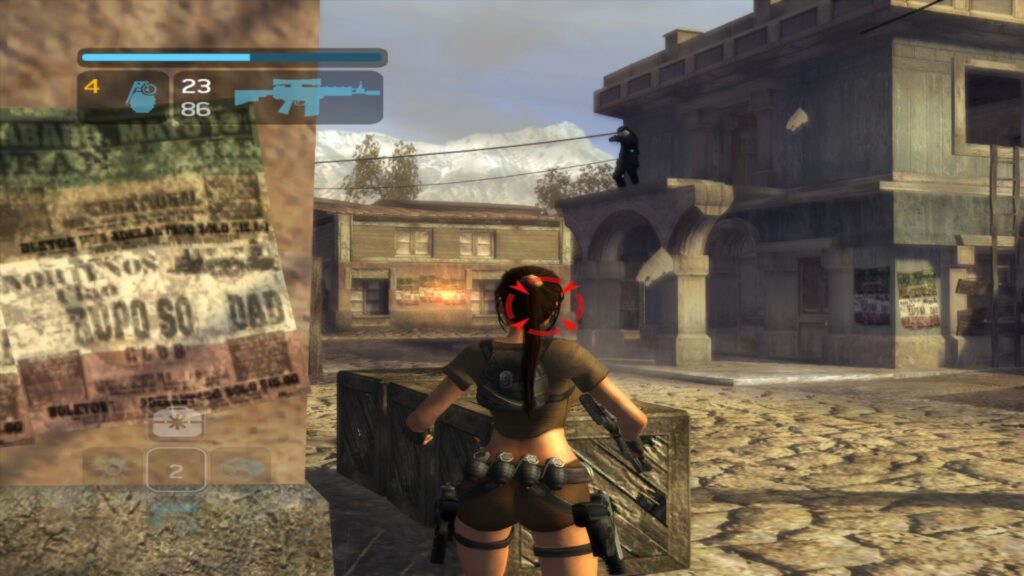Welcome back, adventurer!
Dynamic crystals
Last time we met, game studio Core had egg on their faces from the failure of Angel of Darkness. Eidos, the publisher decided that a fresh take on Lara was needed, if she were to stay relevant nearly a decade after her debut. This led to Eidos contacting the American game studio Crystal Dynamics, who previously worked on the Gex and Legacy of Kain franchises in various development roles, to develop the next game in the franchise. They also got Toby Gard on board, whom you may remember as Lara’s original creator, to help with character design and writing. Crystal Dynamics would go on to head nearly all future mainline games in the franchise.
And it all has to do with the success of this game here, Tomb Raider: Legend. For the time, it was the best-received game in the franchise since Tomb Raider II, and an encouraging return to form compared to the relative rut of the recent entries. Legend promised to bring Lara to the next generation of gaming hardware while being a more approachable game to newcomers. It was a lot to ask, but were Crystal Dynamics up to the task?
“I thought you were dead!”
Lara’s mother Amelia is at the center of this game’s plot. As survivors of a plane crash in the Himalayas, Amelia and a young Lara take shelter in a temple. There they find a magical portal that sucks Amelia into it, and she’s presumed dead ever since.
A few years later, Lara is up to her tomb-raiding shenanigans with some teenage colleagues in Peru, when the ruin starts collapsing around them. Lara escapes, however one of her friends—Amanda Evert—is also seemingly killed.
I found both of these plot lines to be frustratingly rote for the medium and storytelling at large. Legend’s overarching story is a first for the franchise, spanning multiple games in a more cohesive manner than the likes of Chronicles and Last Revelation. None of the other characters left much of a mark on me, and those who did did so for the wrong reasons. I’ll get more into those later.
Other than that, it’s your standard globe-trotting adventure, this time with Lara seeking fragments of Excalibur. She visits a wide variety of locales and settings, from ancient Nepalese ruins to a Tokyo skyscraper to a run-down English amusement park centered around the legend of King Arthur. Here more than ever, it seems like the designers picked locales out of a hat and built the story around them. Only Chronicles beats it in that respect, but Chronicles bears the honor of being the veritable Tomb Raider Clip Show.
Visual Revamps
Legend has the benefit of releasing at the end of the sixth generation of console hardware, and at the very start of the seventh. The environments and models look good for their time, but there’s a strange addition to the PC version that I want to touch on first.
While this was a cross-generation title, the PC version of the game allows you to switch between the old- and new-generation graphics. This does a lot more than just add new visual flourishes or make the frame rate smoother, it overhauls a ton of textures and lighting. This makes for a hugely mixed result. Some areas appearing much too dark, and others having textures mapped incorrectly. Think of rivers flowing into nowhere and stone columns floating a foot off the ground.
This issue may be a result of playing a game meant for older PCs on hardware not realized until over a decade later. The effect got so bad that, even with a flashlight at my disposal, I had to turn off the next-gen graphics just so I could see what I was doing in some areas. After a while, I just left it off as the changes weren’t necessarily better, just different.
Seventh-Gen Blues
It’s funny how age changes you. When this game came out, and when the seventh-generation was in full swing, I was in my late teens and early twenties. The gaming industry has always pursued trends. If one popular, critically lauded game had a new gameplay element to it, there were sure to be loads of imitators popping up. When you’re playing games with these elements at their height of popularity, they tend to stick out less. But dust off a game well after its time in the sun, and these elements stick out. I often wonder what modern gaming trends will fall out of favor when I’m in my forties and beyond. So far I can think of a few that I’d like to see gone. Writing this now, I realize that I may be coming off as an old gaming fart, whinging on about any new fad that takes the gaming world by storm. But I do think that some of these mechanics won’t be missed in the long run.
Of all the “modern” game trends in Legend, the Quick Time Events stuck out to me the most. Having an exciting cinematic interrupted by a button prompt to press in two seconds or less doesn’t make the game any more thrilling, it makes me almost spill my beer reaching for the controller. QTEs have since fallen out of vogue, but they still linger in some games to this day. The “mash this button to open a heavy door” prompts are the most common today.
The other trend, though, I felt hurt the game well beyond “press X to not die”. One of the strengths of the Tomb Raider franchise up to this point was its sense of isolation—just Lara and the traps and treasures in front of her. Sure, there’d be some occasional cutscenes with dialogue or an explosion or two, but otherwise it was quiet exploration for the bulk of playtime. Here, Lara gets an earpiece, where her two sidekicks Zip and Alister chatter away in her ear while she tries to dodge pitfalls and blood-thirsty mercenaries.
I suppose the logic here was that the developers wanted a more dynamic approach to storytelling, where little bits of info about the environments and characterization could be sprinkled into the game in a way that doesn’t break game flow. My issue here was that it destroyed that sense of being a lone adventurer completely. The ancient, decrepit tombs Lara explores are now interspersed with cries of “Gee willikers, look at the writing on this wall. Isn’t that neat?”
That’s not to say that this change is a complete failure. There’s one place where this banter clicked with me, and that was the level set inside an abandoned King Arthur museum. Dioramas litter the museum, telling Arthur’s legend with cheap models and a corny voice over. Zip and Alister bicker back and forth over the inaccuracies of the museum its portrayal of Arthurian history. It hit just right for me, and I think it was thanks to the setting. An intentionally dull, corny museum feels right for banter, where unspoiled ruins simply do not.
Grid-be-Gone
Legend also featured more changes beyond dated trends. Some were objective improvements while others just fell into the “strange” category. The older, grid-based movement of the previous games is finally gone for good. Lara now moves fluidly through the levels, with little thought or time needed to set up jumps. I made the comparison many games ago that it felt like I was controlling software, and that has been fully supplanted here in Legend. While I’m here for this more intuitive adventure, a part of me enjoyed the blocky movement of the PS1 classics.
There’s also a small progression system in Legend, though its impact was so insignificant to the overall experience that I’m a little confused as to why they even bothered to include it in the first place. Occasionally Lara’s pistols receive upgrades to hold more ammo or do more damage. While I’ll take this any day over Angel of Darkness’s intrusive and occasionally non-sensical progression, I feel that the game would have been better off without it.
It’s funny, too, that they didn’t bother implementing these upgrades to all the weapons in the game, and why they didn’t apply them to one of the largest changes to this game. Weapons now have an effective distance, and Lara’s accuracy drops dramatically once her target is out of range. It’s almost comical how her shots go from dead on to barely being able to hit the broad side of a barn when what she’s shooting at moves even a foot away. This system of aiming and shooting could have played well into an upgrade path for these weapons. Increasing their range is something I would have strived for during my playtime, striving for any edge I could get over my foes.
The last is an objective improvement in every way: the grappling hook. I like to joke that a grappling hook is the best way to get me to think a little more highly of a game, and it certainly worked here. The grapple uses the game’s physics system to pull distant objects towards Lara, swing across chasms, and manipulate puzzle objects. It’s something I always found fun to use.
Wrap-up
It’s interesting to think of this game as dated, whereas I didn’t quite feel the same about the original Tomb Raider. It’s almost like the thirty-year cycle kicked in and made the very first game much more compelling than Legend was for me. The likes of Dark Souls and its many imitators showed that it can be rewarding to not treat your players like cattle to be herded. Let them roam free, and they’ll come around to the plot when they’re good and ready. Consider, perhaps, driving a used car. You’ll turn more heads in either a brand new car, or one from the sixties, compared to one from the late nineties. But let me be clear: Legend is not a bad game. I’ll take it over some of the flabbier or broken entries which came before.
So, all this to say, should you play Tomb Raider: Legend? I’d say yes, and to get your hands on this one any way you can. It’s not perfect, and can be a bit of a time capsule in some unflattering ways, but it’s so far been the most approachable way to get into the series. As of this writing, I haven’t played Legend’s follow-up which resolves these storylines. For now, all I have to go on is the fairly weak cliffhanger of an ending here. It left me wanting more, but only barely.
Legend is short, though, and my first play-through clocked in at around seven hours. In this age where we’re spoiled for choice and have a million shows and books and movies to catch up on, playing a game that doesn’t feel like a part-time job is genuinely refreshing.
It’s also the start of Crystal Dynamic’s turn at developing Tomb Raider games, and you’ll be able to see where their design choices and changing trends took the franchise from the aughts to present day.
While this game took Tomb Raider in new, interesting directions, what if the original game still held some gems to uncover, polish, and present to a modern audience? Crystal Dynamics decided to find out with their release of Tomb Raider: Anniversary, a celebration of the franchise’s tenth birthday. Hope to see you around for that one as well.




